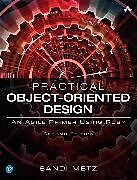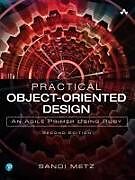Practical Object-Oriented Design: An Agile Primer Using Ruby
Einband:
Kartonierter Einband
EAN:
9780134456478
Untertitel:
An Agile Primer Using Ruby
Genre:
Programmiersprachen
Autor:
Sandi Metz
Herausgeber:
Pearson Education
Auflage:
2. Auflage
Anzahl Seiten:
288
Erscheinungsdatum:
22.08.2018
ISBN:
978-0-13-445647-8
Autorentext
Sandi Metz is a programmer, teacher, author, and sometime consultant. In the past 30+ years she has written innumerable applications and creates practical solutions that produce working software that is easy to change. She has spoken about object-oriented design and refactoring at international Ruby conferences since 2009.
Klappentext
Sandi Metz has distilled a lifetime of conversations and presentations about object-oriented design into a set of Ruby-focused practices for crafting manageable, extensible, and pleasing code. She shows readers how to build new applications that can survive success and repair existing applications that have become impossible to change. Each technique is illustrated with extended examples, all downloadable from the companion Web site, poodr.info.
The first title to focus squarely on object-oriented Ruby application design, Practical Object-Oriented Design in Ruby will guide students to superior outcomes, whatever your previous Ruby experience. Novice Ruby programmers will find specific rules to live by; intermediate Ruby programmers will find valuable principles they can flexibly interpret and apply; and advanced Ruby programmers will find a common language they can use to lead development and guide their colleagues.
Zusammenfassung
The Complete Guide to Writing Maintainable, Manageable, Pleasing, and Powerful Object-Oriented ApplicationsObject-oriented programming languages exist to help you create beautiful, straightforward applications that are easy to change and simple to extend. Unfortunately, the world is awash with object-oriented (OO) applications that are difficult to understand and expensive to change. Practical Object-Oriented Design, Second Edition, immerses you in an OO mindset and teaches you powerful, real-world, object-oriented design techniques with simple and practical examples.Sandi Metz demonstrates how to build new applications that can “survive success” and repair existing applications that have become impossible to change. Each technique is illustrated with extended examples in the easy-to-understand Ruby programming language, all downloadable from the companion website, poodr.com. Fully updated for Ruby 2.5, this guide shows how toDecide what belongs in a single classAvoid entangling objects that should be kept separateDefine flexible interfaces among objectsReduce programming overhead costs with duck typingSuccessfully apply inheritanceBuild objects via composition Whatever your previous object-oriented experience, this concise guide will help you achieve the superior outcomes you’re looking for.Register your book for convenient access to downloads, updates, and/or corrections as they become available. See inside book for details.
Inhalt
Introduction xvAcknowledgments xixAbout the Author xxiChapter 1: Object-Oriented Design 11.1 In Praise of Design 21.2 The Tools of Design 41.3 The Act of Design 61.4 A Brief Introduction to Object-Oriented Programming 101.5 Summary 13Chapter 2: Designing Classes with a Single Responsibility 152.1 Deciding What Belongs in a Class 162.2 Creating Classes That Have a Single Responsibility 172.3 Writing Code That Embraces Change 242.4 Finally, the Real Wheel 332.5 Summary 35Chapter 3: Managing Dependencies 373.1 Understanding Dependencies 383.2 Writing Loosely Coupled Code 413.3 Managing Dependency Direction 533.4 Summary 59Chapter 4: Creating Flexible Interfaces 614.1 Understanding Interfaces 614.2 Defining Interfaces 634.3 Finding the Public Interface 654.4 Writing Code That Puts Its Best (Inter)Face Forward 774.5 The Law of Demeter 804.6 Summary 84Chapter 5: Reducing Costs with Duck Typing 855.1 Understanding Duck Typing 855.2 Writing Code That Relies on Ducks 955.3 Conquering a Fear of Duck Typing 1005.4 Summary 103Chapter 6: Acquiring Behavior through Inheritance 1056.1 Understanding Classical Inheritance 1056.2 Recognizing Where to Use Inheritance 1066.3 Misapplying Inheritance 1146.4 Finding the Abstraction 1166.5 Managing Coupling between Superclasses and Subclasses 1296.6 Summary 139Chapter 7: Sharing Role Behavior with Modules 1417.1 Understanding Roles 1427.2 Writing Inheritable Code 1587.3 Summary 161Chapter 8: Combining Objects with Composition 1638.1 Composing a Bicycle of Parts 1638.2 Composing the Parts Object 1688.3 Manufacturing Parts 1768.4 The Composed Bicycle 1818.5 Deciding between Inheritance and Composition 1858.6 Summary 191Chapter 9: Designing Cost-Effective Tests 1939.1 Intentional Testing 1949.2 Testing Incoming Messages 2029.3 Testing Private Methods 2159.4 Testing Outgoing Messages 2179.5 Testing Duck Types 2219.6 Testing Inherited Code 2339.7 Summary 244Afterword 245Index 247

Leider konnten wir für diesen Artikel keine Preise ermitteln ...
billigbuch.ch sucht jetzt für Sie die besten Angebote ...
Die aktuellen Verkaufspreise von 6 Onlineshops werden in Realtime abgefragt.
Sie können das gewünschte Produkt anschliessend direkt beim Anbieter Ihrer Wahl bestellen.
Loading...
Die aktuellen Verkaufspreise von 6 Onlineshops werden in Realtime abgefragt.
Sie können das gewünschte Produkt anschliessend direkt beim Anbieter Ihrer Wahl bestellen.
| # | Onlineshop | Preis CHF | Versand CHF | Total CHF | ||
|---|---|---|---|---|---|---|
| 1 | Seller | 0.00 | 0.00 | 0.00 |
